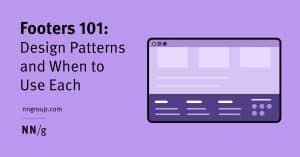The footer of a website is frequently overlooked in comparison to other design elements, despite the fact that it plays an essential part in the overall users’ experience. Footers on websites have the potential to improve navigation, increase user engagement, and supply crucial information if they are developed with careful consideration. The purpose of this article is to guide you through the process of creating a website footer that is not only user-friendly but also entertaining and makes a lasting impact on your visitors. How to Craft a User-Friendly and Engaging Website Footer
Why Your Website Footer Matters
Your website’s footer acts as an anchor, directing viewers to important information that they might have overlooked in the main body of your website. When users leave your website, this is frequently their last opportunity to interact with your content. It is possible to enhance navigation, give additional information, and strengthen the legitimacy of your brand with a footer that has been thoughtfully developed.
Improving User Experience
An improved user experience (UX) can be achieved by the use of a footer, which facilitates the accessibility of vital information such as contact data, connections to social networking platforms, and important pages such as privacy regulations. Users that scroll to the bottom of a page are often seeking for something specific, and a footer that is successful can assist them in finding it with least effort on their part.
Boosting Engagement
It is also possible for a footer to function as a tool that helps users remain engaged with your website. The inclusion of social media buttons, links to popular blog entries, and subscription forms can all be effective ways to stimulate additional involvement.
Key Elements of an Effective Website Footer
To create a footer that is not only user-friendly but also entertaining, you need to incorporate things that are helpful to the people who are visiting your website. The essential elements that make up an efficient footer are as follows.

1. Navigation Links
The provision of navigation to crucial pages that consumers may require after scrolling through your website is one of the most critical roles that a footer is able to do. There are frequently connections to the following included in this:
A brief explanation of your business or website is included in the “About Us” section.
You can direct users to a contact page that contains your email address, phone number, or contact form by using the phrase “Contact Us.”
Legal documents that users may require access to are included in the “Terms and Conditions” and “Privacy Policy” sections.
There is a link to frequently asked questions for customer service that is referred to as “FAQs.”
As these links are frequently the ones that visitors are looking for the most, you should make sure that they are easy to locate.
2. Contact Information
The footer of your website is an excellent location to include your contact information. For the purpose of locating your email address, phone number, or physical location, a significant number of visitors will look here. The consumer experience can be improved for companies that have many locations by providing a link that is specific to the place or by using a store locator. https://diversewebsitedesign.com.au/website-development-hobart/
3. Social Media Links
A fantastic method for promoting your profiles and encouraging consumers to follow your business is to incorporate social media icons into your footer at the bottom of your website. It is important to ensure that the icons can be clicked on, and to minimize clutter, you should keep to the platforms that are most relevant to your company.
4. Email Subscription Form
You might want to think about including an email subscription form at the footer of your website if expanding your mailing list is a top objective. In light of the fact that readers who reach the bottom of the page are frequently looking for additional information, an opt-in form at this location can be extremely beneficial. Check that the form is easy to understand and that it is visually consistent with the rest of your design.
5. Copyright Information
The practice of including a copyright notice in the footer is considered to be widespread. Not only does this safeguard your intellectual property, but it also lends an air of professionalism to your website. Verify that the copyright year is updated on a consistent basis so that it accurately reflects the current year.
6. Legal Links
It is required for the majority of websites to include links to their terms of service and privacy and security policies. It is recommended that these links be prominently displayed in the footer, where they will be easily accessible without being intrusive. This is of utmost significance for websites that are involved in e-commerce because they are required to comply with a variety of legal restrictions.
Designing an Aesthetically Pleasing Footer
Not only is the content of your footer extremely important, but the design of your footer also plays a significant influence in the overall user experience. A footer that is cluttered or overly complicated might be overwhelming for visitors, whereas a design that is clean and well-organized will make a great impression from the beginning.
Keep It Simple
Both clarity and concision are essential for your footer. In order to avoid confusing consumers, you should avoid squeezing an excessive amount of content into the space. It is important to focus on the most important aspects and to arrange them in a manner that is simple to understand. You can divide the material into sections or columns to make it easier to read.

Use Consistent Branding
You should make sure that the color scheme, typography, and branding of your footer are consistent with the rest of your website. Users will have a continuous experience as they explore your website as a result of our solution. Ensure that your company’s logo is featured, and that the design accurately reflects your brand identity as a whole.
Ensure Readability
Considering that footers are often situated at the bottom of a webpage, it is not uncommon for people to overlook them. Take measures to ensure that the text is easily readable by selecting a font size and color that is readable and that contrasts well with the background. It is best to steer clear of utilizing fonts or colors that are too small or blend in with the background.
Mobile Optimization for Footers
In the current digital environment, it is of the utmost importance to make sure that your footer caters to mobile devices. It is currently true that mobile visitors make up a sizeable fraction of the total site traffic, and a footer that is not properly optimized might result in exceptionally high bounce rates.
Responsive Design
The bottom of your website ought to be able to adapt to varying screen sizes without compromising its functionality or aesthetic appeal. Take measures to ensure that elements such as text, icons, and links can be readily clicked on and read on screens that are lower in resolution. Utilizing a grid layout that is responsive, which may change its appearance depending on the device that is being used, is a recommended practice.
Prioritize Key Information
When it comes to mobile footers, it is crucial to emphasize the information that requires the most attention. The navigation links, contact information, and social networking icons should be your primary focus. In order to maintain a clean and uncomplicated footer, you can conceal components that are not as important by employing collapsible sections.
Test Across Devices
In order to guarantee that your footer functions correctly, you should always test it on a variety of devices and screen sizes. It is important to pay attention to the user experience across various platforms, making sure that all of the connections are operational and that the layout is not altered.
Common Footer Mistakes to Avoid
The process of creating an intriguing footer involves not just deciding what to include, but also deciding what to leave out. The following is a list of common errors that should be avoided:
Overloading with Links
It may be tempting to include as many links as possible in your footer; but, doing so may cause readers to feel overwhelmed and may also give an appearance of clutter. Pay attention to the connections that are the most important, and try to avoid cramming too much information into the available area.

Ignoring Mobile Users
Optimising for mobile devices is extremely important, as was noted earlier. Users may become frustrated and have a terrible experience as a result of a footer that functions properly on desktop computers but is inaccessible on mobile devices.
Outdated Information
Also, make sure that your footer is always up to date. Having obsolete contact information, old copyright dates, or broken links to social media platforms can be detrimental to your trust. Always make sure to verify and update the footer to reflect any changes that have occurred in your company.
Conclusion
If it is built properly, a footer has the potential to be an effective instrument for improving the user experience, increasing engagement, and generating conversions. The creation of a website footer that is both user-friendly and entertaining may be accomplished by include essential components such as navigation links, contact information, social networking buttons, and making certain that your footer is compatible with mobile devices. In order to retain the appearance polished and professional, it is important to remember to keep the design basic, consistent with your brand, and consistent with regular updates.





